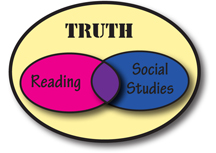Christian teachers can have different ideas about what qualifies as biblical integration. The following is a list of things that, generally speaking, do NOT qualify as biblical integration.
Biblical Integration IS NOT:
- Including a Bible verse at the top or bottom of a worksheet.
- Diagramming a Bible verse in grammar class.
- Reading one or all the Bible verses on horses after a horse unit.
- Using a science experiment as an analogy to the Christian life.
- Praying once or several times a day in class.
- Having class devotions.
- Casually referring to the greatness of God during a science lesson.
- The biblical justification for obedience and working hard.
Prayer and devotions are necessary and integral parts of a Christian classroom, but alone, do not qualify as biblical integration. Biblical integration is something that is planned and can and should be carried out throughout the academic day. Simply stated, here is what Biblical Integration is:
Biblical Integration IS:
Seeing how the topic reveals the character or nature of
- God
- Creation
- Mankind
- Moral Order
- Purpose
Thinking Biblically and Critically
The goal of Biblical integration is to help students to think biblically and critically about every subject. Further, the goal is for students to think biblically and critically about every aspect of their lives. Ideally, students should seek to see each subject the way God sees it. When students truly understand something from a biblical perspective, they should gain a greater understanding of the character or nature of God, or have a greater understanding of how God designed things to be.
| In order to do that, there are a few foundational concepts that students need to understand. First, students need to understand that Truth is absolute and knowable.
Christianity is grounded on the basis that truth and knowledge come from God because God is Truth. (Illustration 1) Without this foundation, truth becomes subjective, and not knowable in the same absolute sense. |

Illustration 1: All Truth is God’s Truth. God is Knowledge, Wisdom, and Truth. |
| Sometimes academic subjects are taught as separate entities, outside of a biblical understanding or framework. However, this compartmentalizes subjects, which can prohibit students from seeing the greater design of God.
Subjects should not be taught in mere isolation, but taught in such a way as to reveal the character, nature, or handiwork of God. (Illustration 2) |

Illustration 2: The truth of any subject should be seen through the understanding of God, Truth, Knowledge and Wisdom, not as a subject outside of the realm of Truth. |
| Teachers often integrate multiple subjects in order to increase student interest and awareness, which is good. The integration of math and science, or reading and social studies does help students to see a bigger picture, to gain a greater understanding of the lessons being taught.
Not only should the subjects be integrated where appropriate, but that integration should be done from a biblical perspective. The integrated of multiple subjects should occur within the greater understanding of the Christian worldview. (Illustration 3) |

Illustration 3: Integrated subjects should be taught from a Christian perspective. |
| One goal in teaching from a biblical worldview perspective is to highlight the truth, and reveal the errors. Through the course of study, students should see the truth of a subject as God sees it, and identify the fallacies, again as God see them.
Other religions or worldviews are appealing because they often contain elements of the truth, but may not have all truth. (Illustration 4) |

Illustration 4: A subject may contain elements of the Truth and elements that are false. That is what makes them appealing. |
Teaching from the Christian Perspective
Simply stated, biblical integration is taking a lesson objective and/or lesson outline, and teaching it from a Christian perspective. It is not just a lesson or objective devoid of God, his character, nature, or creation, nor is it solely about God, his character, nature or creation. It is a melding of the two. It is understanding the objective or lesson from the Christian point-of-view.
*Note: Biblical integration is not something that just happens at the end of a lesson. Students should be encouraged to think Biblically all throughout the lesson. Remember, seeing something from God’s perspective is not a separate task, unless that is the lesson objective. For instance, students may compare and contrast how Christians understand a lesson in comparison with how a pantheist or naturalist might see it. Sometimes when the integration happens last, students tune out, figuring it won’t be on the test or that the integration is just an add-on. The goal of good integration is for students to view a subject the way God does, and to see how this understanding impacts them personally as well as society at large.
Teaching Resources
This site has several FREE resources for helping teachers through the entire process of integrating biblical principles into every subject.
- Check out the brainstorming page to learn how to brainstorm entire units or individual lessons.
- Then visit the lesson plan page to learn how to incorporate those biblical principles into individual lessons.
- Finally, visit the posters page to learn about the hottest resource available – Christian Worldview Posters.

